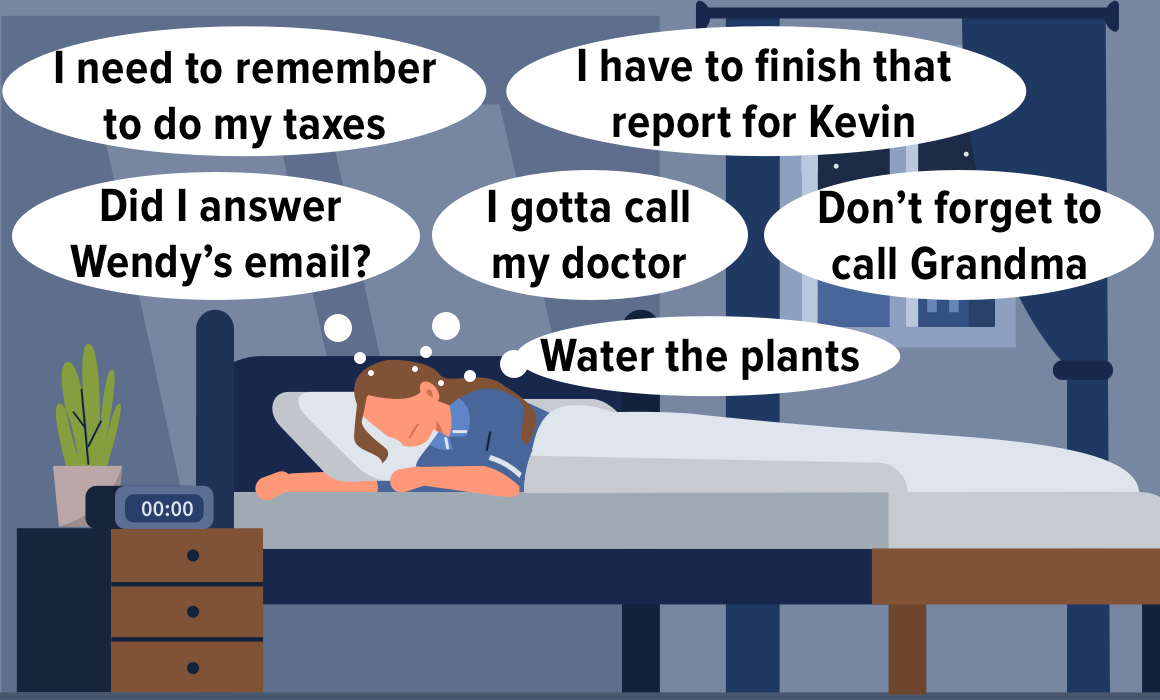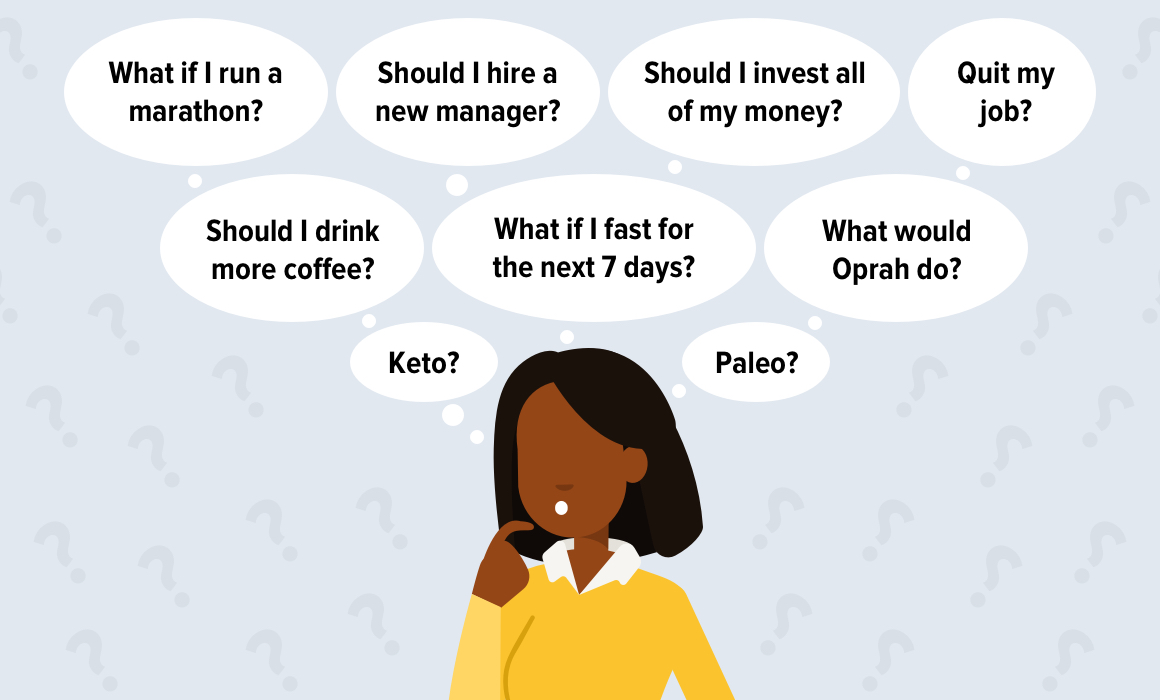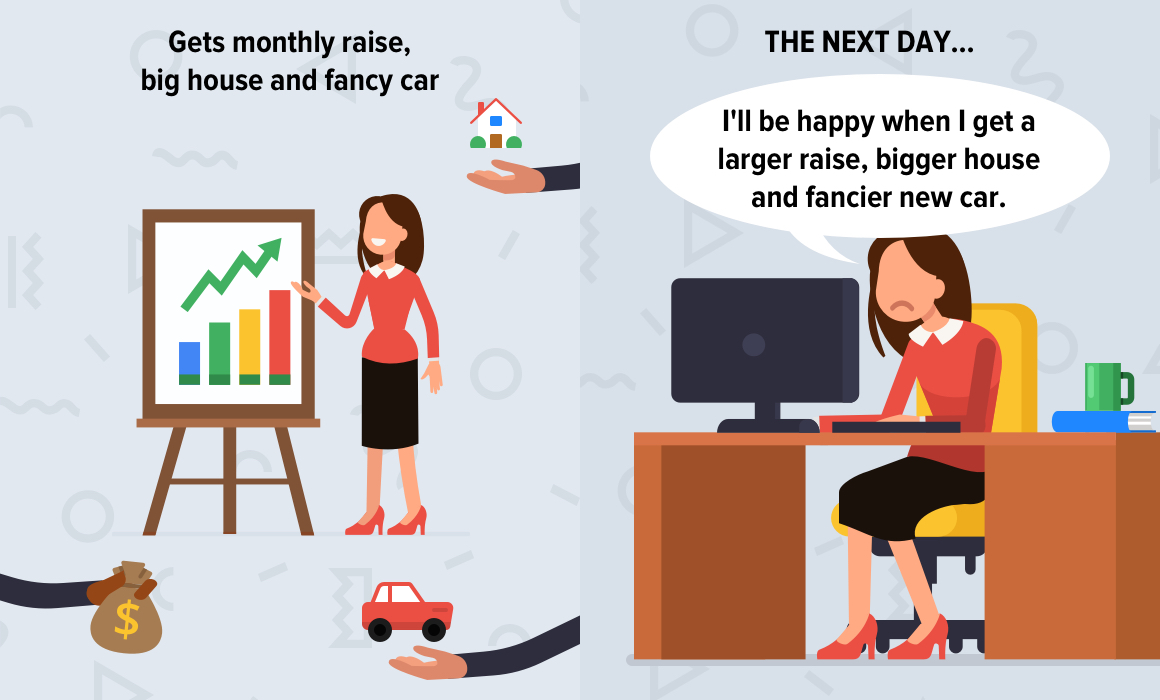Once upon a time, economists believed that human beings are inherently rational creatures. This assumption stems from the idea that when faced with two options, we opt for the choice that maximizes well-being. However, our time management skills have proved otherwise, and it turns out most of our decisions are driven by subconscious biases.
We complain about being pressed for time after failing to use our free time wisely.
We procrastinate, binge-watch TV, and max out our credit cards.
We cut coupons to save on a fifty-cent can of soup but splurge on a lavish meal.
We take on more than we can handle and act surprised when we don’t reach our deadlines.
The list goes on and on because let's face it: Humans are not good decision-makers. People act outside of their self-interest all the time, and research has found multiple biases that lead to poor decision-making and time management. Patterns of irrationality can be studied, recorded, and hopefully avoided. In the 1970s, Amos Tversky and Daniel Kahneman disputed the original theory that humans act exclusively in self-interest and uncovered a new field of study in behavioral economics.
This article will focus on 7 cognitive biases that dramatically affect our abilities to make rational decisions and efficiently manage our time. Predictable irrationality has been studied extensively, and therefore we can identify useful strategies to help you curb these cognitive traps.
The Mere Urgency Effect

How do you decide what to prioritize when everything feels equally important? Unfortunately, a sense of urgency leads us to prioritize in the least rational way possible.
The Mere Urgency Bias states that we are more likely to prioritize time-sensitive tasks than essential tasks. Important tasks are generally more time-consuming, complicated, and lack a specific deadline; thus, we gravitate towards tasks with easy to reach, visible goals. Urgent tasks are often seen as scarce and valuable, which tricks us into thinking they should be prioritized over important projects.
This bias explains why we get sucked into trivial tasks over big projects, despite our drive for impactful work. Email is a perfect example of this; we feel an overwhelming urgency to respond and drop whatever we are dossing. Because there are no immediate consequences to putting off important tasks, they often get put on the back burner, and we fail to conquer opportunities for impactful work.
How to Avoid the Urgency Trap
The Eisenhower Matrix is a productivity strategy that will help you prioritize what is truly important. In this matrix, you visualize priorities in four separate categories:
- Urgent and important tasks need to be completed as soon as possible.
- Urgent and unimportant tasks can be delegated to someone else.
- Non-urgent and important tasks you can schedule for later.
- Non-urgent and unimportant tasks should be deleted from your to-do list.
Urgency motivates people to complete their work, and any procrastinator knows that a sense of urgency is sometimes the only way to finish a project. However, it’s often challenging to separate urgent items from important items because we naturally associate urgency with importance. Use the Eisenhower Matrix to avoid this trap and shift your focus to more impactful work.
Related Post: The Multitasking Myth: How To Truly Increase Productivity
The Zeigarnik Effect

Have you ever wondered how servers can take your order without a pen and paper while remembering you wanted no tomatoes, extra mushrooms, and a singular ice cube in your water? In the 1920s, Russian psychologist Bluma Zeigarnik noticed that cafe servers could remember their unfinished tabs better than closed tables. This suggested that people are more likely to remember an incomplete or interrupted task than those completed, known as the Zeigarnik Effect.
This effect works positively to remind us to tie up loose ends before beginning a new project, but as soon as uncompleted tasks pile up, our attention splits. When your focus spits, it becomes much more challenging to engage in deep work and complete meaningful tasks. A study measuring the effects of unfulfilled goals on the mind’s cognitive abilities found that unfinished tasks cause intrusive or distracting thoughts, poor performance, and decreased productivity.
Unfortunately, this cognitive bias follows us home, making it challenging to relax and focus on our relationships. Although you have physically left work, your mind is preoccupied with incomplete tasks, and work feels like it never really ended. These feelings intrude on family dinners, weekend plans, personal matters, and sleep patterns. Releasing yourself from the Zeigarnik effect means you can mentally disconnect your personal life from work.
How to Avoid the Zeigarnik Trap
Thankfully, avoiding the Zeigarnik effect doesn’t mean you have to finish all of your tasks by the end of the workday. Research shows that simply writing down a plan for completing them will relieve your brain from the stress of incompletion.
Make a to-do list: We all have a lot going on, and our brain can only file through so much information, so make a list! Find a convenient, easy-to-use digital to-do list that helps you easily manage your day, such as Todoist, TickTick, or Any.do.
Find a task management system: Adopt a ritual for reviewing and organizing your tasks for the week so your brain doesn’t have to keep track of everything going on. Designing a system you trust will ensure you’re working on the right things at the right time and prioritizing effectively. Use Asana, Trello, Jira, or Wrike to manage your tasks and stay organized.
Tip: Try using your Asana board in calendar mode so you can see upcoming deadlines and visualize the big picture, so you’re not wasting time on busywork.
Don’t let email intrude on your day: Email is one of the most significant disturbances to your workflow and can quickly contribute to your list of unfinished tasks. Shift aggregates all of your email accounts together and lays them out in an intuitive sidebar. You can add all of your email accounts, mute notifications, and integrate your most-used apps to streamline your workflow.
Have an end-of-workday routine: Make a plan for the next day and add all unfinished tasks to a to-do list so you’re not bringing the stress of incompletion home with you.
Kickstart your brain: The Zeigarnik Effect can be used to your advantage when you’re not sure where to begin on a project. Take a small step towards the end goal to kickstart your brain and trigger a flow of new ideas.
The Planning Fallacy

The history of grand construction projects has highlighted tendencies to predict optimistic and even unrealistic completion times. For example, the Sydney Opera house was built 10 years after its original estimated completion date, and the Olympic Stadium in Montreal was completed nearly 13 years past! Unfortunately, this phenomenon is not limited to commercial mega-projects and has been seen predominantly in everyday life. Automotive experts underestimate the time it will take to fix a damaged car. New homeowners plan a housewarming party before they have even finished unpacking.
The worst part is, we continuously underestimate the time it takes to complete a project, even when we know we’re likely to underestimate a deadline. A study showed that regardless of previous knowledge about the time it takes to complete a specific task, we rely on an optimistic viewpoint and are likely to project a completion date before the deadline.
Optimism isn’t the enemy. The planning fallacy encourages many of us to start daunting projects because we have underestimated the time and work it takes to complete. Ignorance is bliss but can also lead to increased stress levels and feelings of guilt.
Often we fail to meet deadlines, but deadlines are also the reason we get our work done, especially for the procrastinators out there, so how do we stay realistic?
How to Avoid the Planning Trap:
Break projects into smaller parts: If you break up large projects into smaller, more manageable pieces, it will be easier to estimate the time to complete. You deserve recognition for the steps you’re taking towards a bigger goal. Once you have broken up a project into more granular steps, you can add up the time of each task to realistically nail down a completion date.
Access your time frame: First of all, don’t bite off more than you can chew. If you’re slammed in the next couple of weeks, taking on a massive project with a short deadline isn’t in your cards. Planning your work and having a visual schedule that maps out all of your upcoming tasks will enable you to project what you can and can’t take on. You can integrate all of your Google calendars, Asana boards, and time management apps into Shift to efficiently organize your time.
Base your deadlines on historical data: Tracking the time it takes to complete a task will provide you with a timestamp to refer to when a similar project comes downstream. Use a time tracking tool like Toggl, ntask, or set up a Pomodoro cycle in Todoist, all of which seamlessly integrate with Shift.
The Sunk Cost Fallacy

We have all encountered the sunk cost fallacy. Once you have invested any amount of time and effort into a project, it’s only natural to think it’s all gone to waste as soon as you call it quits. The unfortunate truth is that no matter how unclear the outcome may be, we are so resistant to stop in our tracks that we continue along a road that leads nowhere.
A sunk cost can be any type of investment, such as time, money, or exerted energy. We often seek rewards on the investments we have made, so merely dropping a project because it has no future value feels almost impossible. We want so badly for our investments to be “worth it,” that we continue to dump time, energy, and money into insignificant projects. Why are we so compelled to see our investments go to use? Well, in part, because society tells us we have to. We’re told never to quit something, and if we keep pushing, we will succeed — only, that is a proven misconception. We are so scared to walk away feeling like we have failed when failing is the most logical thing to do in many circumstances.
Despite how disappointed you feel with previous decisions you’ve made, we are tied to these decisions by the Sunk Cost Fallacy. Let’s face it, we have all forced our eyes open begrudgingly for a boring book, yet we continue reading because we have already invested some amount of time. Maybe you’ve been on the same career path for 10 years, and you’re no longer content in your position, but you choose to stay despite the ongoing resentment for that decision. Unfortunately, the Sunk Cost Fallacy limits us from seeing our failures as possible opportunities for growth and success in uncharted territories.
How to Avoid the Sunk Cost Trap
Evaluate the opportunity cost: Every decision you make has two costs - the cost of investment and the opportunity cost. The first cost is the investment of time, energy, or money. The second cost is the benefit you would have received from the next best alternative option. For example, when you’re thinking of quitting your job, the focus tends to fall on the money you’ll be losing rather than the potential happiness you’re giving up by staying. Weighing out your options by evaluating the potential benefits of pursuing a different course of action will help you pull the string on sunk costs. Identify which alternative you will be giving up when you continue to invest more time, energy, or money into a particular course of action.
Tip: We tend to weigh money more heavily when evaluating opportunity cost, so remember to consider joy and satisfaction as an equally contributing cost.
Check on your commitments periodically: Have you ever gotten to the end of a project only to find it has led you nowhere, or the outcome wasn’t what you were searching for? This is because we continue to pour in resources while failing to check on the project’s status. Periodically evaluating the potential benefits/downfalls of continuing on your course of action will help you manage your time and energy more efficiently. Integrate quarterly decision points for each project to evaluate whether you should continue or pull the plug. You can set reminders in task management apps to check in on your progress and weigh out the opportunity cost. Try apps like Asana, Airtable, Ally, Any.do or Clickup.
Related Post: The 20 Best Time Management Tools for a Productive 2021
Present Bias

The present Bias is the tendency to favor options that offer immediate rewards over future-oriented options. For example, when offered $100 now or $200 in 2 years, many people will choose the immediate reward, even though the output would be more significant in the future. Those of us who struggle with procrastination are very familiar with the present bias. Ignorance doesn’t always equate to bliss, and in regards to procrastination, ignorance or avoidance can be your greatest enemy.
This bias leads us to prioritize our current happiness over future satisfaction and continually put off challenging yet rewarding endeavors. Our impatience hinders us from setting ourselves up for future success and seeing the big picture in most decisions. When we fail to follow through with our resolutions, goals, and responsibilities, we dig ourselves deeper into a hole that only our future selves can figure out.
How to Avoid the Present Trap
Think about your future self: Set yourself up for success. Make difficult or dreaded tasks easier to complete by taking small steps towards your goal, so it's easier to pick up the pieces when the time comes. For example, if your goal is to exercise more frequently, lay out your workout clothes the day before so you can simply get dressed and go. If you need to finish a report by Friday but find yourself getting trapped in your email inbox, mute notifications so you can dive into deep work. Maybe you have a hard time saving for the future? Set up an automated transfer into your savings account each month.
Bundle tasks together: Getting through a dreadful task is much more enjoyable when you pair it with an activity you love. For example, you probably don’t want to spend your weekend cleaning or folding laundry, but if you throw on a Netflix show while you work, it becomes much more fun.
Reframe your reward thinking: When it comes to reaching your goals, the motivation to achieve the desired goal is not enough to keep you going — you need to enjoy the process. A study conducted on accomplishing your goals found that people were more likely to achieve their goals when they found joy in the process. Put less weight on results and give yourself recognition for the small steps you’re taking towards your goal.
Complexity Bias

The complexity bias refers to our tendency to give undue credit to complex solutions over simple ones. When faced with two alternative options, we usually opt for the most complex one and see simple solutions as inadequate. Humans are complex creatures. We like to believe that life should be just as complicated as we are — turning simple solutions into chaos. For example, a person might be feeling tired and ask their doctor to check their iron levels, ignoring the fact that they have been consistently sleep-deprived and leaning towards a more complicated explanation.
Complexity keeps life exciting but ultimately encourages you to work hard and not smart. Of course, we all love the complexity of a fancy coffee routine or whipping up a gourmet dinner instead of eating leftovers, but such a complicated lifestyle is not sustainable.
“Most geniuses—especially those who lead others—prosper not by deconstructing intricate complexities but by exploiting unrecognized simplicities.” - Andy Benoit
The problem with complexity is that once you have developed an elaborate routine, it doesn’t take too long to fall off track and complexity quickly turns to chaos. Any complex system — be it a morning routine, business venture, or marketing campaign — is challenging to manage and discourages you from reaching your goals. We are always looking for wider, bigger explanations for things while ignoring the fundamentals of a project and looking for simple solutions.
How to Avoid the Complexity Trap
Apply Occam’s Razor: Many philosophers follow Occam’s Razor, suggesting that the simplest solution is generally correct. This is the most effective tool for overcoming the complexity bias. When faced with two alternative options, choose the one that requires the fewest assumptions and relies on foundational concepts.
Take a realist approach: Maybe you’re trying a new diet or productivity technique; you don’t have to go to the full extreme right away. Be realistic and take baby steps towards your goals while adapting your new routine. Look for systems that align with your most natural inclinations. Instead of swinging to intermittent fasting to lose weight, try the more straightforward solution of just eating healthier. Your aspirations will sustain the long term if you remain realistic in adopting new solutions.
Hedonic Adaptation

We are always concerned with our happiness, looking for ways to measure it, and often ignoring simple gratitudes. Hedonic adaptation is the theory that regardless of positive or negative influences in our lives, we always fall back to a stable happiness level. This standard leaves us questioning whether we are truly happy and sends us on an endless search for quantitative happiness — which is arguably, non-existent. We pursue a raise at work, buy a new car, or look for other people to fulfill our “happiness.” But when we finally achieve these things, we return to a stable level of happiness, and our achievements are disguised behind the new norm.
How sustainable is this pursuit of happiness when the outcome leaves us feeling empty and unfulfilled?
How to Avoid the Hedonic Trap
Break up your goals into smaller (more manageable) parts: Many of us gravitate towards big life goals such as graduating, buying a house, or exercising 5 days a week because we are taught to go big or go home. If you break up your goals into smaller milestones, you will feel accomplished more frequently instead of waiting years for a slight boost in happiness.
Focus on the process, not the outcome: If your only source of happiness or fulfillment is reaching your goal, you will burn out much quicker. Enjoy the journey and give yourself recognition every step of the way. Don’t obsess over the idea of reaching success and instead savor every moment of getting there.
Make your priorities clear: Take a step back and evaluate what's most important — for many of us, that lies with our relationships. Meaningful relationships are the most significant predictor of long-term happiness and health. Working from home has presented challenges for many of our relationships, so make sure that you are intentional with your efforts to keep your relationship strong.
Conquer Time Management Chaos With Shift
Time management goes hand in hand with organizational skills and there's no better tool than Shift to keep your browser organized while streamlining your workflow. You can integrate all of the best time management apps into Shift, aggregate your emails in one spot and create customized workspaces for big projects. Focus your workflow with Shift and conquer time management biases by adding all of the top time tracking tools, personalizing your account, and visualizing your goals in a detailed browser.















 Share on Facebook
Share on Facebook Share on Twitter
Share on Twitter







